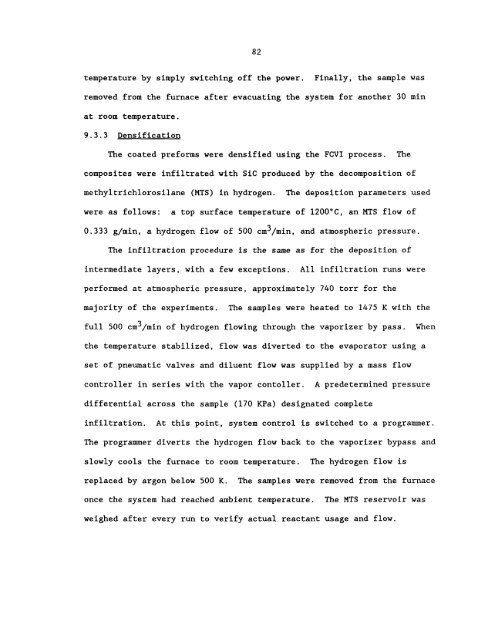Characterization and control of the fiber-matrix interface in ceramic ...
Characterization and control of the fiber-matrix interface in ceramic ...
Characterization and control of the fiber-matrix interface in ceramic ...
You also want an ePaper? Increase the reach of your titles
YUMPU automatically turns print PDFs into web optimized ePapers that Google loves.
82<br />
temperature by simply switch<strong>in</strong>g <strong>of</strong>f <strong>the</strong> power. F<strong>in</strong>ally, <strong>the</strong> sample was<br />
removed from <strong>the</strong> furnace after evacuat<strong>in</strong>g <strong>the</strong> system for ano<strong>the</strong>r 30 m<strong>in</strong><br />
at room temperature.<br />
9.3.3 Densification<br />
The coated preforms were densified us<strong>in</strong>g <strong>the</strong> FCVI process. The<br />
composites were <strong>in</strong>filtrated with Sic produced by <strong>the</strong> decomposition <strong>of</strong><br />
methyltrichlorosilane (MTS) <strong>in</strong> hydrogen. The deposition parameters used<br />
were as follows: a top surface temperature <strong>of</strong> 12OO0C, an MTS flow <strong>of</strong><br />
0.333 g/m<strong>in</strong>, a hydrogen flow <strong>of</strong> 500 cm3/m<strong>in</strong>, <strong>and</strong> atmospheric pressure.<br />
The <strong>in</strong>filtration procedure is <strong>the</strong> same as for <strong>the</strong> deposition <strong>of</strong><br />
<strong>in</strong>termediate layers, with a few exceptions. All <strong>in</strong>filtration runs were<br />
performed at atmospheric pressure, approximately 740 torr for <strong>the</strong><br />
majority <strong>of</strong> <strong>the</strong> experiments.<br />
The samples were heated to 1475 K with <strong>the</strong><br />
full 500 cm3/m<strong>in</strong> <strong>of</strong> hydrogen flow<strong>in</strong>g through <strong>the</strong> vaporizer by pass.<br />
When<br />
<strong>the</strong> temperature stabilized, flow was diverted to <strong>the</strong> evaporator us<strong>in</strong>g a<br />
set <strong>of</strong> pneumatic valves <strong>and</strong> diluent flow was supplied by a mass flow<br />
<strong>control</strong>ler <strong>in</strong> series with <strong>the</strong> vapor contoller.<br />
A predeterm<strong>in</strong>ed pressure<br />
differential across <strong>the</strong> sample (170 KPa) designated complete<br />
<strong>in</strong>filtration. At this po<strong>in</strong>t, system <strong>control</strong> is switched to a programmer.<br />
The programmer diverts <strong>the</strong> hydrogen flow back to <strong>the</strong> vaporizer bypass <strong>and</strong><br />
slowly cools <strong>the</strong> furnace to room temperature.<br />
The hydrogen flow is<br />
replaced by argon below 500 K.<br />
The samples were removed from <strong>the</strong> furnace<br />
once <strong>the</strong> system had reached ambient temperature. The MTS reservoir was<br />
weighed after every run to verify actual reactant usage <strong>and</strong> flow.

















